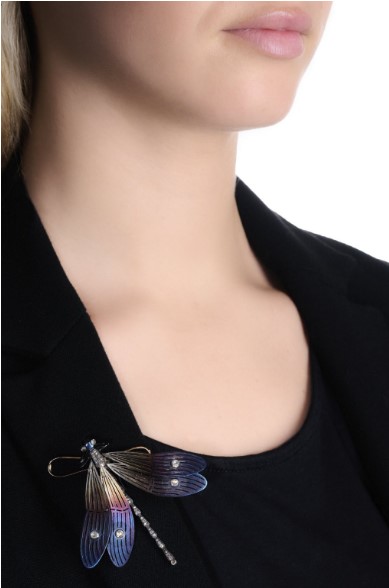Is a Diamond also a Gemstone?
Jewelry fans love collecting all sorts of items from rings to earrings. Searching for them online or in retail stores is a big part of adventure—the hunt has its own thrill! But what many collectors wonder is what to call each of their sparkling treats—and more importantly—what’s what?
What’s a Gemstone?
What exactly IS a gemstone first of all? Let’s look it up, shall we? A peek inside our trusty Encyclopedia Britannica defines gemstone as, “any of various minerals highly prized for beauty, durability, and rarity.” It broadens the scope to include non-crystal stones, because we love all things gemmy, don’t we? “A few non-crystalline materials of organic origin like pearl, red coral, and amber also are classified as gemstones.”
So, when you speak of diamonds for example, you may call them a gemstone. They are a mineral composed of just one element—that being carbon. In the case of pricey and oh-so gorgeous color diamonds, trace amounts of other elements contribute to their eye-catching allure. Boron for example turns a diamond blue. Nitrogen in a diamond crystal lends an attractive yellow tint to the stone.
Colored Stones are Gems too
Other gemmy minerals like those in the beryl family are also called gemstones as they fall into the specific category of what defines a gemstone. Interestingly, all other gemstones outside of diamonds are composed of several elements—not just one (carbon) like the diamond.
Industry experts expand on the gemstone definition somewhat—which is helpful to both serious and casual jewelry collectors. While their list can vary, they unanimously agree that any gemstone—both the colored kind and diamonds should possess ---beauty---durability—and rarity.
Of course—beauty IS in the eye of the beholder, and over time certain gemstones may become all the rage—only to fade from fashion. But like much of fashion—what goes around does eventually come back around when a new generation eyes these stones afresh.
What’s a Jewel?
As long as we’re talking gemstone definitions—what about the word jewel? Turns out, it can be interchangeably used for gemstone. The dictionary gives a concise definition for the word jewel; “a precious stone, typically a single crystal or piece of a hard lustrous or translucent mineral cut into shape with flat facets or smoothed and polished for use as an ornament.”
So, your diamond is a gemstone and a jewel, and a fabulous one at that. Colored gemstones are jewels as well. I suppose we love this topic so much that language developed many ways to express these sparkly stones.
Collect What You Love
Today, collectors are much more engaged with their jewelry collections and buy with intention and forethought. The more you know about the gemstones you collect, the greater your appreciation of them will be. You’ll also begin to develop a discerning eye to collect the best of the species. After all, jewelry is a personal expression of the individual wearer.
Precious v Semi-Precious Stones
Years ago, you heard the expression “precious gems and semi-precious gems.” That was used in earlier times to separate the original “Big 4”: diamond, sapphire, ruby, and emerald from all other stones. Consumers knew those stones were quite pricey owing to their rarity. But fast forward to today and we’ve learned that other colored gems not appearing on the Big 4 short list may have very rare varieties—like Paraiba (Windex blue color) tourmaline for instance. So, the modern consensus is leaning towards calling them all colored stones and let the specific variety be valued at its going rate.
The King of Gems
Diamonds have always held most-favored-status because of their sheer beauty and timelessness. Diamonds have not gone out of style since their discovery centuries ago in India. Their ability to capture light and sparkle (by reflecting light back to the eye) holds us all spellbound. These are true miracles of nature.
Diamonds are proudly called “The King of Gems” owing to their unique attributes. Ranked 10 on the Mohs scale of hardness, diamonds are the hardest material known in the world. This is why diamond jewelry from ancient royalty several hundreds of years back—still amazes us today. The stone’s hardness takes an amazing polish and keeps it looking as brilliant now as it did centuries ago. So, you can trust your diamond jewelry to look just as exciting throughout your entire life. If you leave your diamond jewelry to loved ones someday, your diamonds will be as breathtaking then as they are this very moment.
Lasting Memories
The attribute of diamond’s enduring beauty is one of the reasons why collectors are drawn to memorial diamond jewelry. Lasting memories created in stunning diamonds as a tribute to a loved one is a priceless gift that continues over more than one lifetime—it’s a meaningful jewelry piece that will grow more precious as the years go on—for you and those you may give the piece to someday.
The connection between diamonds and love is fundamental. Diamonds are a beautiful creation that expresses love and commitment. Their durability points to the unbreakable bond of affection that a memorial diamond embodies.
From the cremains of someone you hold dear—or even a stand of hair, a stunning tribute to that loved one can be formed into a radiant memorial diamond that will be a lasting legacy—not in a far-away place—but something you can wear everyday of your life. Turning memories of a loved one or a cherished animal into dazzling wearable beauty is what Heart-in-Diamond is celebrated for. The road from grief to embracing precious memories is best taken with a treasured token of your loved one. ▼



Comments